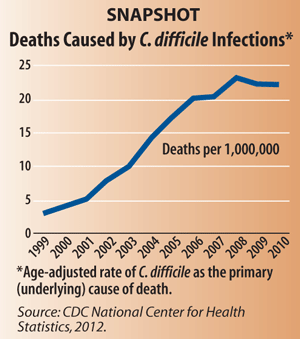A new report released by the Centers for Disease Control and Prevention (CDC) found that Clostridium difficile infections are on the rise in all types of healthcare settings, posing an increased threat to patient safety. The findings show that older adults who take antibiotics and also receive medical care in any setting are at the greatest risk.
During the last decade, hospital stays from C. difficile infections tripled according to CDC’s new Vital Signs report, “Making Healthcare Safer, Stopping C. difficile Infections.” The report found that almost all C. difficile infections are connected to receiving medical care.
The new data revealed that C. difficile infections are linked to 14,000 deaths in the U.S. annually. Between 2000 and 2007, C. difficile-related deaths increased 400%. The dramatic increase was due in part to a recently emerged stronger strain of the bacterium, according to the report’s authors.

Roughly 25% of C. difficile infections first show symptoms in hospitalized patients. But the spike in infections is not limited to hospitals. Notably, three-quarters of C. difficile infections appear in nursing home patients or in people recently cared for in doctors’ offices and clinics.
More than half of infections occur in people older than 65, and this group accounts for more than 90% of C. difficile-related deaths. Generally, children are at a lower risk of developing the infection.
Every year C. difficile infections cost at least $1 billion in extra healthcare costs. Hospitals can combat these costs by following infection control recommendations. The agency recommends that clinicians prescribe and use antibiotics carefully, test for C. difficile when patients have diarrhea while on antibiotics or within several months of taking them, and isolate patients with suspected infections immediately.
The report notes that 71 hospitals in Illinois, Massachusetts, and New York decreased C. difficile infections by 20% in less than 2 years by following infection control recommendations.
The full report is available online.